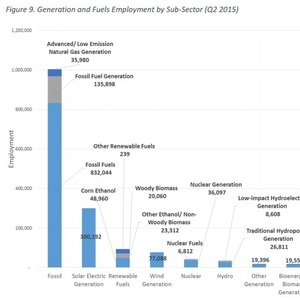DOE releases first annual energy employment report

U.S. Department of Energy
March 30, 2016
BY Erin Krueger
The U.S. Department of Energy has released its first annual energy employment analysis. The report focuses on how changes in America’s energy profile are affecting national employment in the nation’s multiple energy sectors. According to the DOE, its report uses a combination of existing energy employment data and a new survey of energy sector employers to provide a broad view of the national current energy employment landscape.
An estimated 3.64 million Americans currently work in traditional energy industries, including production, transmission, distribution and storage. Of those workers, 600,000 contribute to the production of low-carbon electricity, including renewable energy, nuclear energy and low emission natural gas. According to the DOE, an additional 1.9 million Americans are employed, in whole or in part, in energy efficiency. In addition, roughly 30 percent of the 6.8 million employees in the U.S. construction industry work on energy or building energy efficiency projects.
Advertisement
Advertisement
Regarding biobased renewables, report indicates that the entire U.S. agriculture and forestry industry employs approximately 700,00 workers, with about 20 percent of those jobs contained within “detailed” energy-related industry sub-sectors that could include businesses working directly with generation and fuel technologies. “These detailed industries include corn and sugarcane farming, used for ethanol and biodiesel production, and logging or other forestry services, which contribute to woody biomass and pellet fuel,” said the DOE in the report. “Of these industries, about 18,000 agriculture and forestry employees work to support electric power generation and fuel production.”
Overall, the renewable fuels sub-sector supports 48,960 jobs in corn ethanol, 20,060 jobs in woody biomass, 23,312 jobs in other ethanol/nonwoody biomass, and 239 jobs in other renewable fuels. In addition the bioenergy/biomass generation sub-sector supports 19,559 jobs. These figures take into account employment associated with both generation and fuels.
During the first eleven months of last year, the report shows wood and wood-derived fuels generated nearly 38.77 million MWh of electricity, with other forms of biomass at 19.85 million MWh.
Advertisement
Advertisement
The report, titled “U.S. Energy and Employment Report, relies on a combination of employment data sets including the Bureau of Labor Statistics Quarterly Census on Employment and Wages and the proprietary Energy Employment Index, a supplemental survey developed by BW Research Partnership. This approach provides a quantitative analysis of how the four sectors provide direct employment across the economy within other occupations. DOE will conduct subsequent surveys to provide annual USEER reports that will provide year-over-year analysis of the American energy employment landscape.
A full copy of the inaugural USEER can be downloaded from the DOE website.
Related Stories
CoBank’s latest quarterly research report, released July 10, highlights current uncertainty around the implementation of three biofuel policies, RFS RVOs, small refinery exemptions (SREs) and the 45Z clean fuels production tax credit.
The USDA significantly increased its estimate for 2025-’26 soybean oil use in biofuel production in its latest World Agricultural Supply and Demand Estimates report, released July 11. The outlook for soybean production was revised down.
The U.S. Energy Information Administration maintained its forecast for 2025 and 2026 biodiesel, renewable diesel and sustainable aviation fuel (SAF) production in its latest Short-Term Energy Outlook, released July 8.
XCF Global Inc. on July 10 shared its strategic plan to invest close to $1 billion in developing a network of SAF production facilities, expanding its U.S. footprint, and advancing its international growth strategy.
U.S. fuel ethanol capacity fell slightly in April, while biodiesel and renewable diesel capacity held steady, according to data released by the U.S. EIA on June 30. Feedstock consumption was down when compared to the previous month.
Upcoming Events










